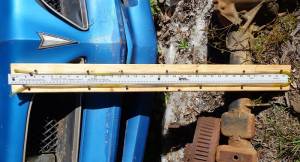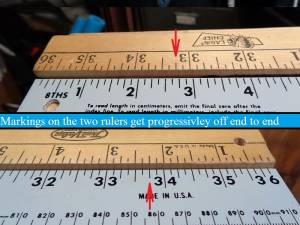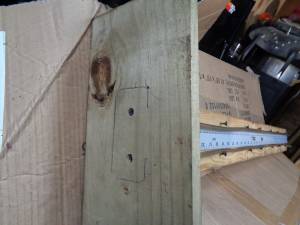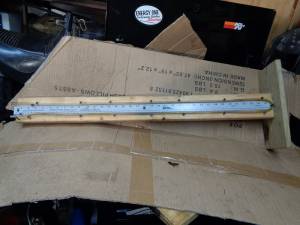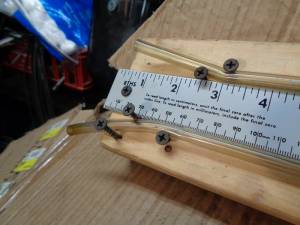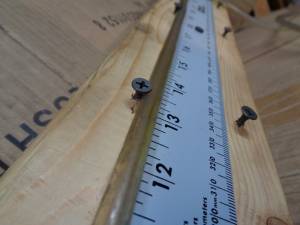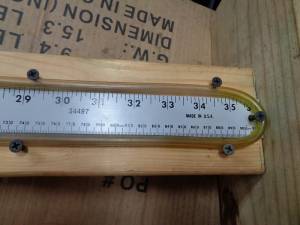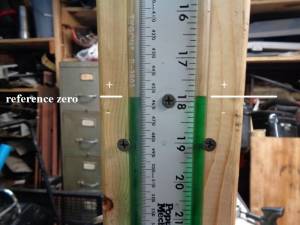Table of Contents
This is an old revision of the document!
REF: Engine Mechanicals - Sub-04E
Building Your Own Slack Tube (Manometer)
See also in the Sportsterpedia:
Building the Unit
Article by Hippysmack of the XLFORUM 1)
The backing plate is a 2×4 with an aluminum 36“ ruler attached with drywall screws. The base is a 12” long piece of 1×6.
The two rulers below (right pic below) show the measurements on the wooden ruler to be 1/8“ longer than the steel one in a 36” run.
Ambient temps can also shrink or expand the ruler whether wooden or aluminum so that has to be taken into account of subsequent tests.
The drywall screws were also used to bind the hose between the ruler and the shank using the screw head to hold the hose down. 4)
The black connector at the top is a cut down spark plug boot used as a sleeve for the hose connections.
(technically if you buy enough length of hose, you don't need the connector)
Just make sure all connections are sealed good.
The engine will suck on the hose for the most part in varying degrees so there's not enough pressure to blow off the hose.
A small piece of plywood screwed to the bottom of the 2×4 makes a nice stand for the unit but it can also be screwed to your shop wall.
Then all you have to do is remove the timing plug, install the new fitting and hook the hose end to it.
Selecting the Tubing
The slack tube above is fitted with 1/8“ clear Tygon vinyl tubing and a 2×4 app 3 feet long. 11) However, any clear vinyl tubing will work (1/4”-1/8“).
You'll need at least twice the length of the tube plus six inches or so for a fudge factor just to fit the tool.
If you plan on making the tube a one piece deal, you'll need the tool length plus the length you plan to have it away from the engine.
The tool needs to sit higher than the outlet at the engine so account for that in length as well.
The clear hose has to be routed away from the pipes and other heat sources.
If need be, you can account for tool length, set the tool where you want it and run a string from the engine source to the the tool to measure length of hose needed.
The tool should be as close to the engine as possible but exact length isn't a huge issue.
The hose from the above tool was fitted with a sleeve (cut portion of a spark plug boot) to connect the tool length of hose to the engine.
Selecting a liquid media
The best liquid to use depends on how much pressure you'll be measuring is the short answer.
Typically, mercury or water is suggested but for use on a Sportster, water is perfectly fine.
The liquid used for the one above is plain ole tap water with food coloring added to it. Green coloring was used as it shows up well in the tube.
Mercury has a density of 13,600 kg/m3 whereas water only has a density of 1,000 kg/m3.
Mercury manometers are typically used in high heat applications such as exhaust manifolds.
Liquid manometers measure differential pressure by balancing the weight of a liquid between two pressures.
Light liquids such as water can measure small pressure differences.
Mercury or other heavy liquids are used for large pressure differences.
For an indicating fluid 3 times heavier than water, the pressure measurement range is 3 times greater, but the resolution is reduced.
Typically, there isn't a large amount of crankcase pressure generated in a Sportster engine.
So slight changes that may be important in diagnosing ongoing wear would not be detected with heavier liquids.
Indicating fluids can be colored water (green or red food coloring works good), oil, benzenes, bromides, and pure mercury.
When selecting an indicating fluid, check the specifications for specific gravity, operating temperature range, vapor pressure, and flash point.
Corrosive properties, solubility, and toxicity are also considerations.
Liquid characteristics in a U-tube Manometer: 12)
- Viscosity should be low.
- Low surface tension is required.
- The liquid should stick on the walls.
- Should not get vaporized.

